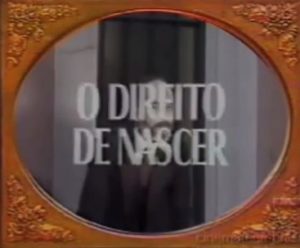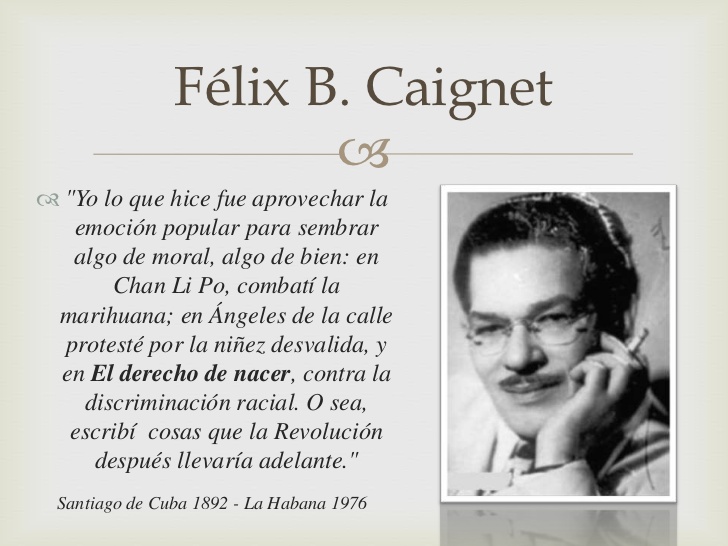The father of those soap operas who catch many people in front of the TV screens, to make them laugh and cry, was a Cuban born in Santiago de Cuba. His name, Felix Benjamín Caignet Salomón. He came to the world, for the good of radio and television, on March 31, 1892.
His parents descended from Franco-Haitian immigrants dedicated to the cultivation of coffee and sugarcane. From a very young age, they moved to the city of Santiago de Cuba, where Félix B. Caignet grew up, listening to the stories of the old storytellers he heard on the streets.
His training was completely self-taught. Very early he began to work writing news of the shows that were presented in Santiago for several media, thus introducing himself into the cultural environment. Later he would write for such popular media as El dia de Cuba, El Fígaro, Bohemia and El Sol newspaper.
In the 1930s, he became part of the collective of the CMKC radio station, making the children’s program “Good afternoon, little boys”, where he undertook the narration of entertaining and funny tales of his inspiration and very unequal themes.
You could already see in his works, the influence exercised on him by the stories heard of the black descendants of slaves in the streets of his city.
When the series for children “Chilín y Bebita” began to air, the substantial contributions of Felix B. Caignet to the radio began to take place. That space, not only entertained the children, but had a high didactic content. And that was how he introduced the episodic genre into the radio, hooking his young listeners with the curiosity to know how those stories would continue, an experience that the author had already lived in his own flesh, and now he was repeating before the microphones on the radio, only that this time it was he who counted.
It was around there that programs for children began to appear on the radio, because until then they had not seen commercial interest in this type of space.
In 1932, at the Rialto theater he premiered the children’s song “El ratoncito Miguel”, which was used by the people later to protest against the dictator Gerardo Machado. Fact by which he was arrested three days in the Moncada Barracks, but was released, thanks to the demonstrations of parents and children who sympathized with his work on the radio.
Back to this medium, through the CMKD of the Palace of the Tower, initiates the transmissions of Chan-Li-Po, the first serial detective show that was broadcast in Cuba. History of a Chinese detective in his wanderings around the island. The first of the chapters was called “The Red Snake”, introducing the figure the narrator in the radio show, acquiring a full domain of suspense and false suspense; leaving thousands of listeners with the anxiety of listening to the next chapter. With this technique he created habits in the listeners.
And in 1948, the first radio soap opera in Latin America, “The right to be born”, began to be broadcast, which would become a paradigm for this genre that was born here, on this radio station of a Creole Cuban city, and that would spread rapidly to other nations of the continent and the world, thanks to Cuba’s exports of this radio product, which also served as the basis for the birth of telenovelas, which later, with its prolonged extension of purely commercial interest, would reach be called “soap operas”.
But its production was very broad. Among his novels are also remembered, “The price of a life”, “The thief of Baghdad”, “Street angels”, “The mother of all”, etc.
And not only dramatized, music also reached its talent. Sones, guarachas, boleros, guajiras, children’s music, countless compositions of deep Cuban roots arose from his inspiration. Among the best known: “Frutas del Caney”, popularized by the Matamoros Trio, “I hate you”, that Rita Montaner sang, “Carabalí”, “Mountains of the East”, “I want to kiss you”, “Lie”, “Silently” , etc.
Félix B. Caignet died in La Havana, on May 25, 1976 were he was buried until his remains were moved to Santiago de Cuba in 1992 in order to honor his wish to be buried near his parents.
LA TELENOVELA, EL FENOMENO AUDIOVISUAL CUBANO. FÉLIX B. CAIGNET.
El padre de esos culebrones que atrapan a muchos frente a las pantallas de la tele, para hacerles reír y llorar, fue un cubano nacido en el santiaguero municipio de San Luis. Su nombre, Félix Benjamín Caignet Salomón. Vino al mundo, para suerte de la radio y la televisión, el 31 de marzo de 1892.
Sus padres descendían de inmigrantes franco-haitianos dedicados al cultivo de café y la caña de azúcar. Desde muy pequeño se trasladan a la ciudad de Santiago de Cuba, y allí crece Félix B. Caignet, escuchando las historias de los viejos cuenteros que oía por las calles.
Su formación fue completamente autodidacta. Muy temprano comenzó a laborar escribiendo noticias de los espectáculos que se presentaban en Santiago para varios medios de prensa, introduciéndose así en el medio cultural. Más tarde escribiría para medios tan populares como El diario de Cuba, El Fígaro, Bohemia y el periódico El Sol.
En la década de 1930 entra a formar parte del colectivo de la emisora CMKC, realizando el programa infantil “Buenas tardes, muchachitos”, donde acometió la narración de amenos y divertidos cuentos de su inspiración y de temáticas muy desiguales.
Ya se podía apreciar en sus obras, la influencia que sobre él ejercieron los cuentos escuchados a los negros descendientes de esclavos en las calles de su ciudad.
Al comenzar a transmitirse la serie para niños “Chilín y Bebita”, comienzan a darse los sustanciales aportes de Félix B. Caignet a la radio. Aquel espacio, no solo entretenía a los pequeños, sino que llevaba un alto contenido didáctico. Y fue así como introdujo en la radio el género episódico, enganchando a sus jóvenes oyentes con la curiosidad de saber cómo continuarían aquellas historias, experiencia que ya el autor había vivido en carne propia, y ahora repetía ante los micrófonos de la radio, solo que esta vez era él quien contaba.
Fue por ahí que comenzaron a aparecer programas para niños en la radio, pues hasta entonces no habían visto interés comercial en este tipo de espacios.
En 1932, en el teatro Rialto estrenó la canción infantil “El ratoncito Miguel”, la que fuera utilizada por el pueblo más adelante para protestar contra el dictador Gerardo Machado. Hecho por el cuál fue detenido tres días en el Cuartel Moncada, pero fue puesto en libertad, gracias a las manifestaciones de los padres y niños que simpatizaban con su labor en la radio.
De regreso a este medio, a través de la CMKD del Palacio de la Torre, inicia las transmisiones de Chan-Li-Po, primer espectáculo seriado detectivesco que se radiaba en Cuba. Historia de un detective chino en sus andanzas por la isla. El primero de los capítulos llevó por nombre “La serpiente roja”, introduciendo la figura el narrador dentro del espectáculo radial, adquiriendo un dominio pleno del suspenso y el falso suspenso; dejando a miles de radioyentes con la ansiedad de escuchar el próximo capítulo. Con esta técnica fue creando hábitos en los radioescuchas.
https://youtu.be/wcm_OYNLqHw
Y en 1948, comienza a radiarse la que sería la primera radionovela de Latinoamérica, “El derecho de nacer”, la que se convertiría en paradigma para este género que aquí nacía, en esta radio de una criolla ciudad cubana, y que se extendería rápidamente a otras naciones del continente y el mundo, gracias a las exportaciones que Cuba realizó de este producto radial, que sirviera de base, igualmente, para el nacimiento de las telenovelas, que más tarde, con su prolongada extensión de interés puramente comercial, llegarían a ser llamadas “culebrones”.
Pero fue muy amplia su producción. Entre sus novelas se recuerdan, igualmente, “El precio de una vida”, “El ladrón de Bagdad”, “Ángeles de la calle”, “La madre de todos”, etc.
Y no solo dramatizados, la música también alcanzó su talento. Sones, guarachas, boleros, guajiras, música infantil, incontables composiciones de profunda raíz cubana surgieron de su inspiración. Entre las más conocidas: “Frutas del Caney”, popularizada por el Trío Matamoros, “Te odio”, que cantara Rita Montaner, “Carabalí”, “Montañas de Oriente”, “Quiero besarte”, “Mentira”, “En silencio”, etc.
Félix B. Caignet murió en La Habana, el 25 de mayo de 1976, donde fue enterrado hasta que sus restos fueron trasladados a Santiago de Cuba en 1992 para honrar su deseo de ser enterrado cerca de sus padres.
Agencies/Cibercuba/Internet Photos/YouTube/Arnoldo Varona/TheCubanHistory.com
THE CUBAN HISTORY, HOLLYWOOD.








![Felix B Caignet_thumb[2]](https://www.thecubanhistory.com/wp-content/uploads/2017/11/Felix-B-Caignet_thumb2.jpg)

